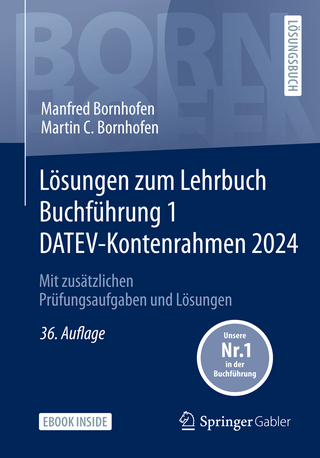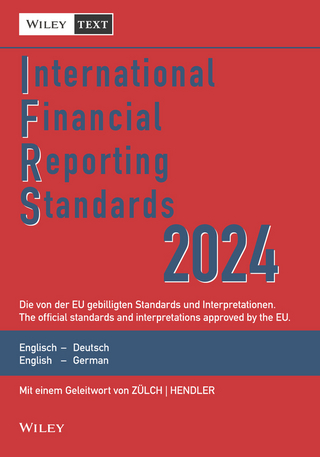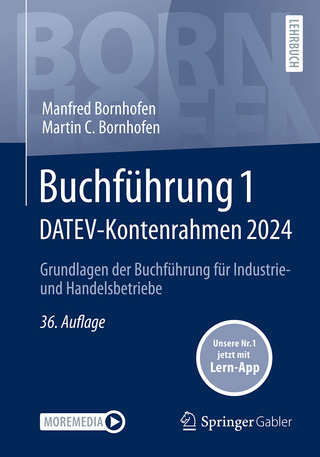
Measuring Business Interruption Losses and Other Commercial Damages
John Wiley & Sons Inc (Verlag)
978-1-119-64791-1 (ISBN)
You hope for the best and plan for the worst. It’s your job. But when the unimaginable happens, are you truly prepared for those business interruption losses?
Measuring Business Interruption Losses and Other Commercial Damages is the only book in the field that explains the complicated process of measuring business interruption damages after you’ve been hit by the unexpected, whether the losses are from natural or man-made disasters, or whether the performance of one company adversely affects the performance of another.
Understand the methodology for how lost profits should be measured
Deal with the many common types of cases in business interruption lawsuits in commercial litigation
Take a look at exhibits, tables, and graphs
Benefit from updated data, case studies, and case law references
Don’t get caught off guard. Get ahead of planning for measuring your interruption losses before disaster strikes.
DR. PATRICK A. GAUGHAN is President of Economatrix Research Associates, an economic and financial consulting firm specializing in the application of economics and finance to litigated matters. Dr. Gaughan provides various consulting services in the field of litigation economics and finance as well as mergers and acquisitions. He is often called upon to serve as an expert witness in lawsuits and other litigated matters.
Chapter 1 Introduction 1
Development of the Field of Litigation Economics 2
Development of the Field of Forensic Accounting 3
Qualifications of an Economic Expert 5
Qualifications of an Accounting Expert on Damages 8
Interdisciplinary Nature of Commercial Damages Analysis 8
Difference Between Disciplines of Economics and Finance 10
Finding a Damages Expert 11
Critically Reviewing a Potential Expert’s Curriculum Vitae 12
Getting the Damages Expert on Board Early Enough 18
Courts’ Position on Experts on Economic Damages 19
Standards for Admissibility of Expert Testimony 21
Exclusion of Experts 25
Trends in Daubert Challenges to Financial Experts 25
Expert Reports 28
Defense Expert as a Testifying Expert, Not Just a Consultant 33
Quantitative Research Evidence on the Benefits of Calling a Defense Expert 35
Treatment of the Relevant Case Law 36
Legal Damage Principles 36
Other Types of Damages Cases 42
Summary 46
References 46
Chapter 2 Economic Framework for the Lost Profits Estimation Process 51
Foundation for Damages Testimony 51
Role of Assumptions in Damages Analysis 52
Hearsay 53
Approaches to Proving Damages 55
Causality and Damages 59
Using Demonstrative Evidence to Help the Client Understand Its Losses or Lack of Losses 67
Causality and Loss of Customers 68
Graphical Sales Analysis and Causality 69
Causality and the Special Case of Damages Resulting from Adverse Publicity 71
Length of Loss Period: Business Interruption Case 72
Length of Loss Period: Plaintiff Goes Out of Business 77
Length of Loss Period: Breach of Contract 78
Methodological Framework 79
Summary 82
References 83
Chapter 3 Economic Analysis in Business Interruption Loss Analysis 85
Economic Fluctuations and the Volume of Litigation 85
Macroeconomic Analysis 86
Definition of a Recession 86
Measuring Economic Growth and Performance 87
Business Cycles and the Movement of GDP Components 90
Business Cycles and Economic Damages 95
Varying Responses to Business Cycles Across Industries 97
Using More Narrowly Defined Economic Aggregates 99
Quantifying the Strength of the Relationship Between Selected Economic Aggregates and Firm Performance 101
Implementing Inflationary Adjustments 104
Regional Economic Trends 108
Quality and Timeliness of Regional Economic Data 109
International Economic Analysis 111
Globalization of Supply and Demand 113
Summary 115
References 116
Chapter 4 Industry Analysis 119
Sources of Industry Data 119
North American Industry Classification System 125
Retaining an Industry Expert 132
Conducting an Industry Analysis 133
Relating Industry Growth to the Plaintiff’s Growth 136
Other Industry Factors 138
Yardstick Approach and Industry Analysis 141
Summary 144
References 145
Chapter 5 Projecting Lost Revenues 147
Projections Versus Forecasts: Economic Versus Accounting Terminology 147
Using Graphical Analysis as an Aid in the Forecasting Process 148
Methods of Projecting Lost Revenues 153
Curve‐Fitting Methods and Econometric Models 158
Understanding Regression Output and Diagnostics 161
Common Problems Affecting Regression Models 162
Confidence in Forecasted Values 167
Frequency of the Use of Econometric Techniques in Commercial Litigation 169
Seasonality and the Forecasting Process 177
Capacity Constraints and Forecasts 179
Sensibility Check for the Forecasted Values 180
Projecting Lost Sales for a New Business 181
Projecting Losses for an Unestablished Business 186
Summary 188
Appendix 189
References 197
Chapter 6 Cost Analysis and Profitability 199
Presentation of Costs on the Company’s Financial Statements 200
Measures of Costs 201
Profit Margins and Profitability 201
Appropriate Measure of Profitability for a Lost Profits Analysis 202
Burden of Proof for Demonstrating Costs 206
Fixed Versus Variable Costs 207
Using Regression Analysis to Estimate Costs as Opposed to More Basic Methods 212
Pitfalls of Using Regression Analysis to Measure Incremental Costs 212
Possible Nonlinear Nature of Total Costs 213
Limitations of Using Unadjusted Accounting Data for Measuring Incremental Costs 217
Treatment of Overhead Costs 220
Must a Plaintiff Be a Profitable Business to Recover Damages? 224
Mitigation of Damages 225
Cash Flows Versus Net Income: Effects on the Discounting Process 230
Recasted Profits 232
Firm‐Specific Financial Analysis 238
Cross‐Sectional Versus Time Series Analysis 240
Summary 240
References 241
Chapter 7 Time Value of Money Considerations 245
Determination of Interest Rates 246
Types of Interest Rates 246
Financial Markets: Money Market Versus Capital Market 247
Money Market Securities and Interest Rates 247
Capital Market 249
Real Versus Nominal Interest Rates 250
Determinants of Interest Rates 255
Prejudgment Losses 261
Components of the Cost of Capital 263
Discounting Projected Future Profits 269
Should the Risk‐Free Rate Be Normalized? 272
Common Errors Made in Discounting by Damages “Experts” 276
Summary 282
References 283
Chapter 8 Business Valuations 287
Legal Standard for Business Valuations in Business Interruption and Business Failure Lawsuits 287
Lost Profits Versus Lost Business Value 290
Business Valuation Framework 292
Public Versus Private Companies 293
Business Valuation Parameters 294
Revenue Ruling 59–60 and Factors to Consider in Valuation 294
Valuation Concepts 298
Capitalization of Earnings 304
Adjustments and Discounts 308
Summary 314
References 316
Chapter 9 Intellectual Property 319
Patents 319
Computation of Damages for Patent Infringement 325
Legal Requirements Necessary to Prove Lost Profits 325
Royalty Arrangements 333
Copyrights 341
Measurement of Damages for Copyright Infringement 344
Trademarks 347
Trade Secrets 352
Summary 355
References 357
Chapter 10 Securities‐Related Damages 361
Key Securities Laws 361
Damages in Securities Litigation 366
Fraud‐on‐the‐Market 367
Comparable Index Approach 380
Event Study Approach 383
Examining the Variation in Abnormal Returns 386
Limitations of the Event Study Model 391
Broker Raiding Cases 394
Merger‐Related Damages 400
History of Mergers in the United States 400
Client‐Broker Claims 405
Churning 407
References 415
Chapter 11 Antitrust 419
Antitrust Laws 421
Antitrust Enforcement 423
Economics of Monopoly 425
Interpretation of Antitrust Violations: Structure Versus Conduct 429
Changing Pattern of Antitrust Enforcement 429
Antitrust and the New Economy 434
Monopolization and Attempts at Monopolization 436
Market Definition and Microeconomic Analysis 440
Market Power 440
Measures of Market Concentration 442
Areeda and Turner’s Marginal Cost Rule of Predatory Pricing 452
Summary 461
References 462
Chapter 12 Economics of Punitive Damages 467
Evolving Position of the U.S. Supreme Court on Punitive Damages 467
Frequency of Punitive Damages 470
Frequency of Punitive Damages and the Shadow Effect of Punitive Damages 471
Purposes of Punitive Damages 473
Compensatory Versus Punitive Damages 474
Criminal Penalties and Punitive Damages in Civil Lawsuits 475
Punishment of Corporations and Corporate Governance 475
Spillover Effects and Punishment of Corporations 476
Deterrence Theory and the Changing Litigation Environment 487
Deterrence and Regulatory Processes 490
Typical Financial Measures Used in the Determination of Punitive Damages 493
Net Worth 494
Market Capitalization 497
Uncertain Litigation Environment 503
Summary 508
References 508
Index 513
| Erscheinungsdatum | 21.08.2020 |
|---|---|
| Verlagsort | New York |
| Sprache | englisch |
| Maße | 163 x 234 mm |
| Gewicht | 794 g |
| Themenwelt | Wirtschaft ► Betriebswirtschaft / Management ► Rechnungswesen / Bilanzen |
| ISBN-10 | 1-119-64791-6 / 1119647916 |
| ISBN-13 | 978-1-119-64791-1 / 9781119647911 |
| Zustand | Neuware |
| Haben Sie eine Frage zum Produkt? |
aus dem Bereich


